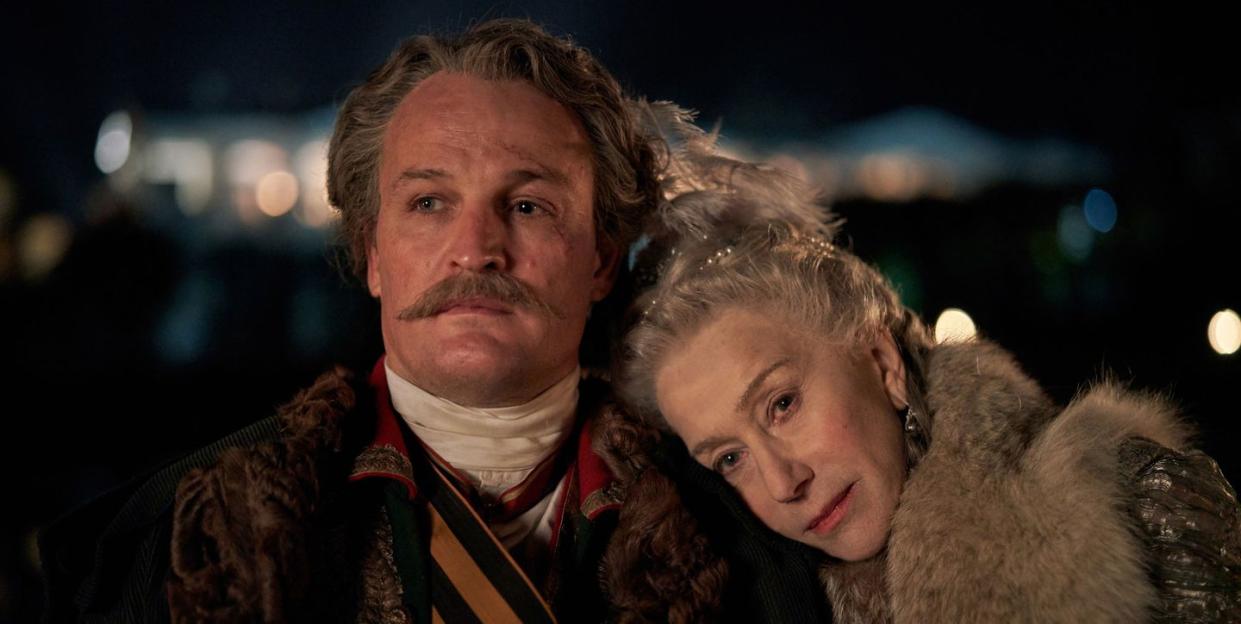Grigory Potemkin and Catherine the Great Have One of History's Greatest Love Stories

Catherine the Great, HBO's latest historically-inspired miniseries, takes an interest in the titular Empress's favorites—and one favorite in particular, Grigory Potemkin, seems to be in a league of his own.
So just who was this military leader, with whom the ruler of Russia was so enamored? Here's what you should know about Potemkin.
He came from relatively humble beginnings.
Grigory Alexandrovich Potemkin was born in 1739 to poor, but aristocratic, family. After being thrown out of university, he joined the Horse Guards in St. Petersburg.

They first met on the day Catherine seized power.
In 1762, when the new Empress emerged from the Winter Palace in a male guardsman’s uniform, having just deposed her husband in a coup, the then-22-year-old Potemkin noticed that she'd forgotten her sword-knot. He quickly went to Catherine to offer her his own.
Later, they would reunite under different circumstances. Potemkin became a celebrated cavalry commander during the Russo-Turkish war. In 1773, Catherine wrote him a letter and he soon returned to court. There, he found that her relationship with Grigory Orlov—who, alongside his brother Alexei Orlov, helped Catherine plot her coup—had floundered. Potemkin saw an opportunity to replace him.
Once he caught Catherine's eye, he quickly climbed through the ranks at court.
Some courtiers admired the Empress's new favorite for his intellect and charm, while others were resentful of his poor manners and tendency towards debauchery. Regardless, Catherine relied on him, and gave him control over the war ministry in addition to a place on the Imperial Council.
The Empress apparently adored him, referring to Potemkin in her letters as her "Twin Soul" and her "Golden Pheasant." It's possible that they were even secretly wed, and Catherine did refer to herself as his "wife" in their correspondence, even adding that she was "attached to you two years ago by bonds of Holy Matrimony."
But being the monarch's favorite wasn't enough for him. In 1776, they developed an arrangement for an open relationship, and Potemkin set out to conquer more lands in Catherine's name.

After that, they took other lovers, but retained a strong partnership—both politically and emotionally.
Potemkin himself would often introduce Catherine to suitable younger lovers, while he began having affairs with his nieces, who Catherine took as her ladies-in-waiting. However, it's thought they they continued to have an on-and-off sexual relationship for the remainder of Potemkin's life.
During this period—considered the "Golden Age" of Catherine's reign—Potemkin was effectively her co-tsar. He enjoyed privileges and access only otherwise afforded to the Empress. Potemkin also vastly expanded the Russian empire, and was eventually appointed the ruler of New Russia (the newly-conquered area near the Black Sea).
He is the namesake for the phrase "Potemkin village," but not in the way you'd think.
Catherine's son and heir, Tsarevich Paul, spread rumors about the settlements Potemkin had built in the south. His political allies and followers fanned the flames, alleging that they were in fact fake towns, designed to mislead the Empress about his success.
In 1787, when Catherine herself visited the Crimea alongside other Western dignitaries, Potemkin was vindicated.
He died in 1791.
Catherine received the news that Potemkin had died in the fall of 1791. "A terrible, crushing blow struck me," she wrote to her friend. "A courier brought me the mournful news that my pupil, my friend, one might say my idol, Prince Potemkin-Tavrichesky has died."
Although she would rule until her death in 1796, it is said that the Empress never fully recovered from his loss.
You Might Also Like